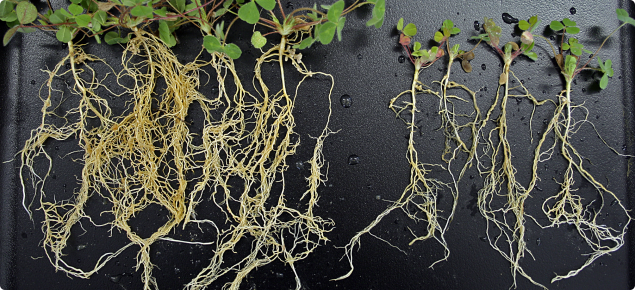In WA, the major problem when soils acidify is aluminium toxicity in the subsurface soil. Low pH in topsoils primarily affects nutrient availability and decreases nodulation of legumes and nitrogen fixation in pastures. These problems are minimised if the topsoil pHCa is maintained above 5.5.
Aluminium toxicity
Aluminium is present in soils in a variety of forms and bound to the soil constituents, particularly clay particles and organic matter. When soil pH drops, aluminium becomes soluble and the amount of aluminium in the soil solution increases. As a rule of thumb, soil aluminium concentration of 2-5 parts per million (ppm) is toxic to the roots of sensitive plant species and above 5ppm is toxic to tolerant species.
In most Wheatbelt soils, aluminium will reach toxic levels when subsurface pHCa falls below 4.8. Generally, there is sufficient organic matter in topsoil so that aluminium can remain bound and does not become toxic to plant roots even though it is extractable in a laboratory analysis.
Toxic levels of aluminium in the soil solution affect root cell division and the ability of the root to elongate. The root tips are deformed and brittle (Figure 1) and root growth and branching is reduced (Figure 2). Poor crop and pasture growth, crop yield reduction and smaller grain size occur as a result of inadequate water and nutrition. The effects of aluminium toxicity are most noticeable in seasons with a dry finish. Roots are unable to effectively grow through acidic subsurface soil, which forms a barrier and restricts access to stored subsoil water for grain filling.
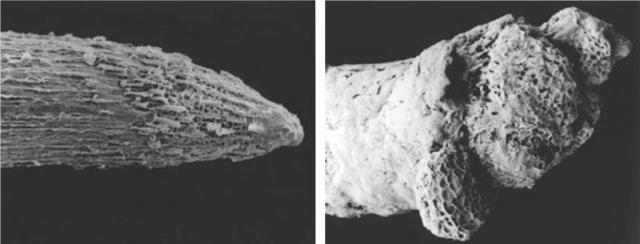
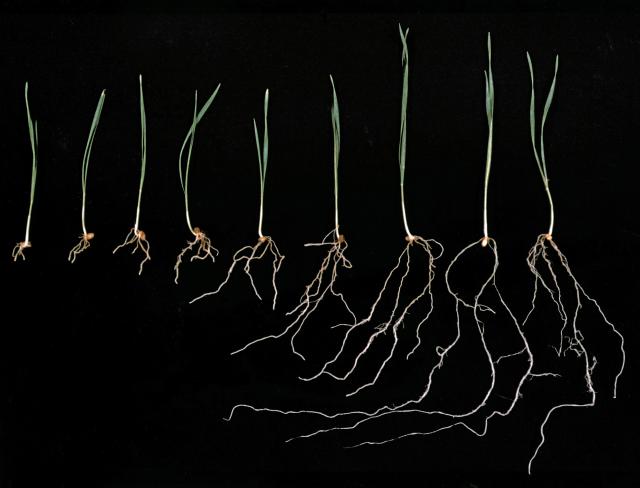
Liming soil to increase the soil pH is effective in reducing the availability of aluminium to non-toxic levels. Figure 3 shows 11 day old barley seedlings grown in acidic subsurface soil. The seedlings on the left were grown in soil that was limed to increase pHCa to 5.1; the available aluminium concentration was less than 2ppm and the seedlings show no symptoms of aluminium toxicity. The seedlings on the right were grown in the same soil without lime, at a pHCa of 4; the available aluminium concentration was 15ppm and root growth was severely restricted by toxic levels of aluminium.
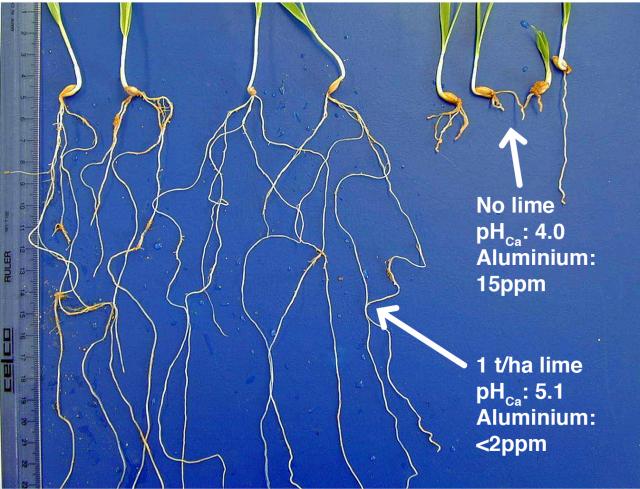
Measurement of soil aluminium
In most cases, the subsurface soil pH will be a good indicator of aluminium levels.
The measurement of aluminium in the soil solution is complicated and is affected by many factors. Depending on the methods used it is not always possible to distinguish between toxic and nontoxic forms of aluminium. A rough guide to the levels of aluminium can be achieved by measuring aluminium concentration in the same 0.01M CaCl2 solution used to measure the soil pH.
The measurement of aluminium in topsoil is further complicated by the presence of higher levels of organic matter because aluminium can be bound to the organic matter (and therefore in a nontoxic form) but is released when extracted with the 0.01M CaCl2 solution.
Soil analyses that present aluminium concentrations for topsoil are not meaningful. Even if a high level of aluminium is extracted from the topsoil during analysis, it is unlikely to be available in toxic concentrations in the soil.
At a subsurface pHCa above 4.5 aluminum concentration is usually less than 2ppm. A pHCa of 4.8 or above in the subsurface will avoid aluminium toxicity for most crop species. Below pHCa 4.5 aluminium concentrations increase rapidly and quickly become toxic to most crop and pasture species (Figure 4).
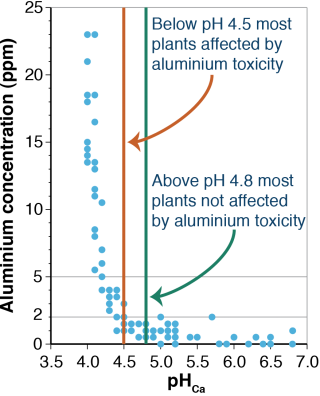
Nutrient availability
Deficiencies of major plant nutrients often occur in acidic soil because nutrients are less available to plants.
The availability of nutrients to plants is altered by soil pH (Figure 5). In acidic soils, the availability of the major plant nutrients nitrogen, phosphorous, potassium, sulfur, calcium, magnesium and also the trace element molybdenum is reduced and may be insufficient.
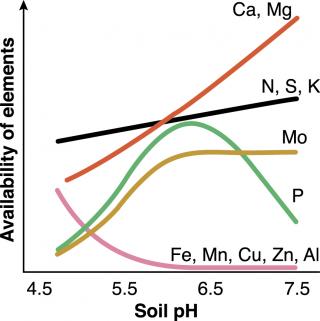
In addition to being chemically less available to plants, nutrients may also be positionally less available due to poor root growth in acidic soils. When root growth is restricted, plants are unable to explore sufficient soil volume to compensate for the reduced chemical availability. In this case, more nutrients than should be necessary would be required for optimal plant growth, however reduced root growth into the subsoil would still limit access to water deeper in the profile.
A 2012 Department of Primary Industries and Regional Development trial at Wongan Hills showed that where lime, but no phosphorus fertiliser, was applied, plant uptake of phosphorus increased. This indicates that soil acidity reduced the availability of phosphorus in the unlimed plots even though it was present in the soil. Additional phosphorus (20 kilograms per hectare) only increased wheat grain yield where lime was also applied (Scanlan et al. 2013).
Phosphorus levels in many WA south-west agricultural soils now exceed more than is required for optimal production, however over 50% of these soils are also below pH 5.5, which can reduce uptake of phosphorus and other nutrients (Weaver and Summers 2013). Liming to raise the pH of acidic soil will increase the availability of these nutrients.
The availability of iron, manganese, copper, zinc and aluminium are increased in acidic soils. In WA, toxic levels of aluminium is usually the only problem. Manganese toxicity can occur in acidic soil in the eastern states of Australia. However, concentrations are rarely high enough in WA wheatbelt soils to be toxic even at low soil pH.
Soil microbial activity
Like plants, the functioning of soil microbes is impaired by acidic conditions.
Pasture legumes may fail to persist in acidic soils.
Most microbial processes, including the breakdown of organic matter and cycling of nutrients, are reduced in acidic soil because growth and reproduction of the soil microbes, primarily bacteria and fungi, are reduced. Micro-organisms break down organic matter and use the carbon and nutrients for their own growth.
Nutrients excess to requirements are released into the soil where they are available to be taken up by plants. The rate of mineralisation of nutrients by soil microbes into plant-available forms is slower in acidic soil, potentially limiting plant uptake.
Importantly, legume nodulation can fail in acidic soil. Legumes are a group of plants that fix their own nitrogen from the air through a symbiotic relationship with specialised bacteria. Under favourable conditions, nitrogen-fixing rhizobia bacteria form a symbiosis (in essence a partnership) with crop and pasture legumes in root nodules (Figure 6).
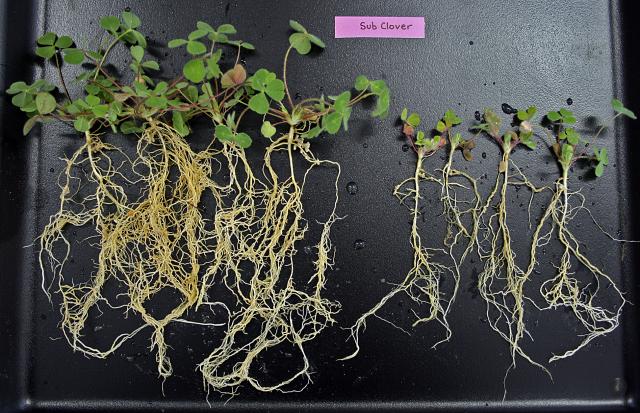
Acidic soils limit both root growth and rhizobia survival, reducing the chances of roots contacting enough bacteria to form a nodule and inhibiting the performance of nodules that do form. In acidic soils, the failure of a functioning symbiosis results in plant nitrogen deficiency.
Species of rhizobia bacteria vary in their tolerance to soil acidity, for example, medic rhizobia are very sensitive and may fail to persist. Grass-dominated pastures can result from the failure of pasture legumes to thrive in acidic soil. Under more appropriate pH levels, the activity of detrimental soil microbes can also be increased and may need to be managed.

